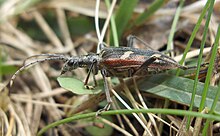| Rhagium bifasciatum | |
|---|---|

| |
| Scientific classification | |
| Domain: | Eukaryota |
| Kingdom: | Animalia |
| Phylum: | Arthropoda |
| Class: | Insecta |
| Order: | Coleoptera |
| Suborder: | Polyphaga |
| Infraorder: | Cucujiformia |
| Family: | Cerambycidae |
| Genus: | Rhagium |
| Species: | R. bifasciatum |
| Binomial name | |
| Rhagium bifasciatum Fabricius, 1775 | |
Rhagium bifasciatum, sometimes called the two-banded longhorn beetle, is one of the most common longhorn beetles in Europe, Turkey and the Caucasus, although it is absent from the far north-east of Europe and some offshore islands, such as Malta. It may reach 22 millimetres (0.87 in) long and can be distinguished by the two prominent pale yellow bands on each of the elytra, although up to seventeen different patterns have been recognised.

Like other longhorn beetles, R. bifasciatum lays its eggs in dead wood, mostly of coniferous trees, where they bore deep, broad tunnels until they are ready to pupate after about two years. The adults feed on a wide variety of coniferous and broad-leaved trees.
References
- Norman Hickin (1999). Longhorn Beetles of the British Isles. Shire Publications. ISBN 0-85263-897-3.
- "Gelbbindiger Zangenbock (Rhagium bifasciatum)". www.naturspektrum.de. Retrieved 18 June 2006.
- "Toflekket bartreløper". Norges Biller (The Beetles of Norway). Naturhistorisk museum, University of Oslo. Retrieved 18 June 2006.
External links
- [REDACTED] Data related to Rhagium bifasciatum at Wikispecies
| Taxon identifiers | |
|---|---|
| Rhagium bifasciatum |
|